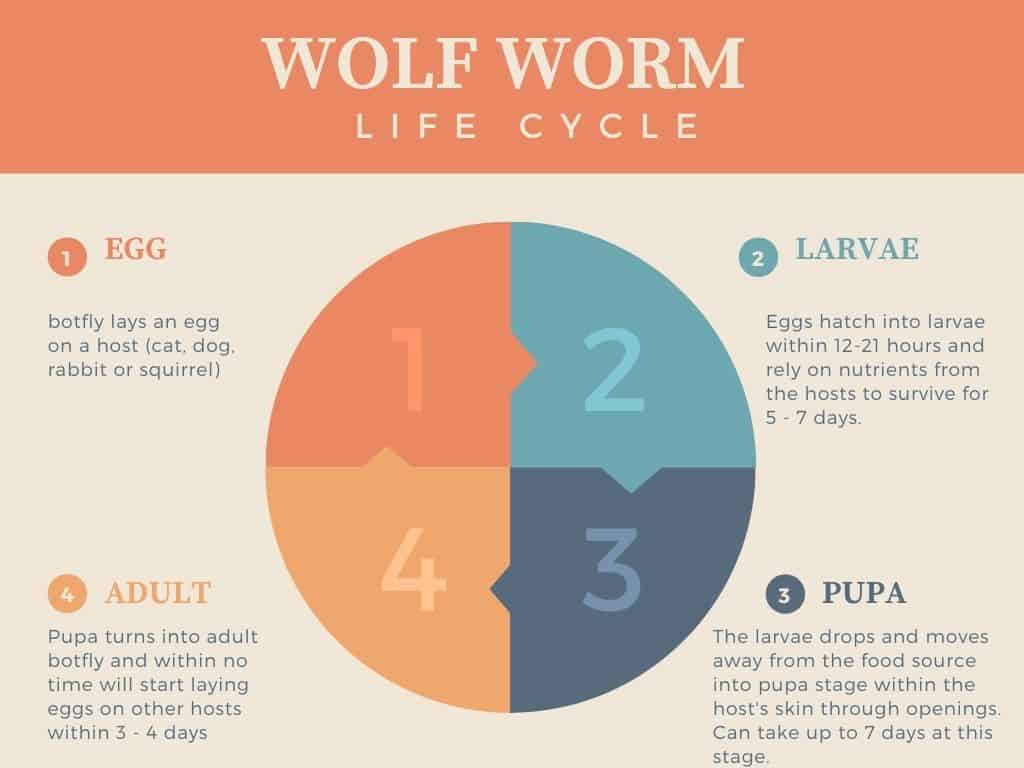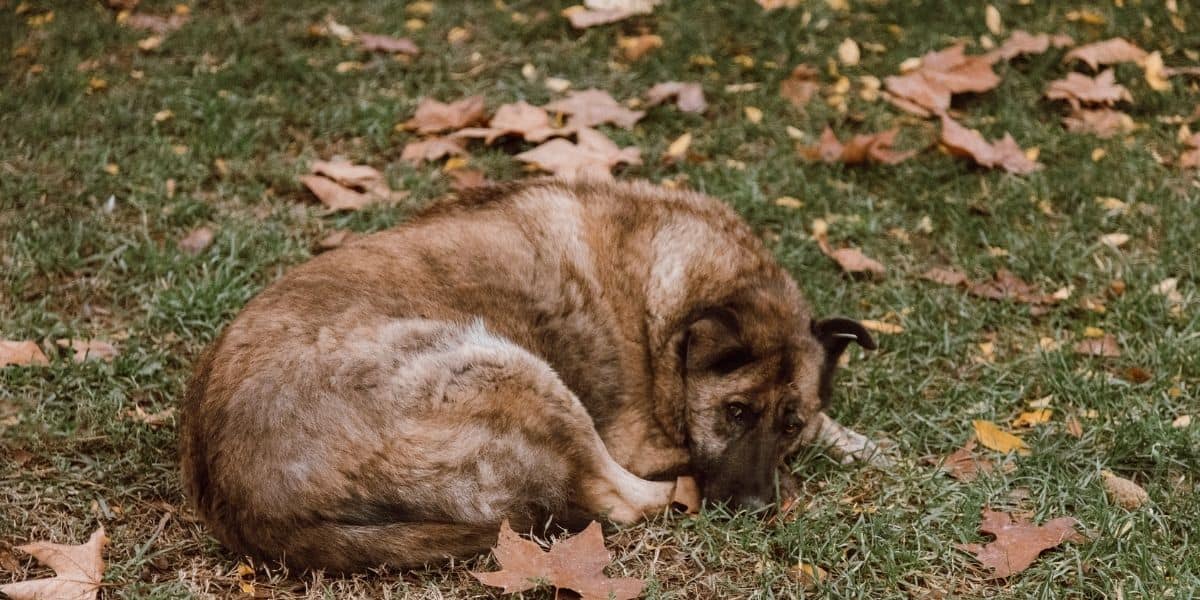As an affiliate, we earn from qualifying purchases on Amazon. We get commissions for purchases made through links in this post.
You’ve probably been wondering, what exactly are wolf worms? Where do they come from? What causes them and are there ways to treat and prevent them from affecting our pet friends?
Wolf worms are one of the most disgusting and vile creatures on the planet. These parasitic insects inject their eggs into the skin of their host, where the eggs hatch and the larvae begin to eat the host’s flesh.
Botflies are responsible for the spread of some of the most deadly diseases on the planet, and their presence is a sure sign of impending disaster.
If you are a pet owner and pet lover just like me, you’ve probably been wondering what exactly this means for your furry little friend? Are there ways to protect them?
Lucky for you, in this article, we will be covering everything wolf worms-related with the hope of ensuring you have a better understanding of this topic.
Let’s get straight into it.
What Are Wolf Worms (Botfly / Warble Fly)?
Wolf worms are parasites that feed on different rodents such as rats and squirrels but sometimes affect our pet friends such as cats, rabbits, and dogs. They are also known as warbles or botfly larvae and are disgusting parasites that inflict lots of pain on whatever creatures they infect. Once botfly lay their eggs on the host, they’ll start to grow within the host and later own exit as wolf worms through openings (nose, eye, or form a wound).
So what are wolf worms? Wolf worms, also known as warble flies or botflies, are a species of fly that is known for their parasitic behavior. The botfly larva attaches itself to a host, such as a squirrel, cat, deer, or dog, and feeds on the host’s tissue. Botflies are not known to be dangerous to humans, but they can be quite bothersome.
Other parasites are less noticeable and may be hard to actually see or feel right away. The wolf worm is not one of these parasites, instead, they are known to cause extreme pain and needs to be taken care of right away.
The actual parasite that infects these different animals is the botfly larva. The adult botfly looks like a cross between a bee and a horsefly and is not itself dangerous, but the eggs that it lays are where the problems come from. These eggs will later on grow and form wolf worms inside the host’s body.
Wolf worms are easy to treat but the entire process can be hard to watch and a very extensive process.
Let’s now look at where exactly these parasites come from.
Where Do Wolf Worms (Botfly / Warble Fly) Come From?
Wolf worms that infect animals come from the botfly eggs. The adult bot fly will lay their eggs at the entrance of burrows for rabbits and rodents, making it a perfect space to infect these animals. The botfly specifically lays their eggs here because it is a prime spot for their larva hatching, as they have a ready supply of nutrients to keep them growing.
The adult bot fly may also deposit the eggs right onto the animals’ skin directly, giving them a more direct path to the host animal.
In other cases, the bot fly may use an intermediate vector such as a housefly or mosquitoes to deposit their eggs onto the host. By the way, did you know dogs also get mosquito bites?
With this ready supply of nutrients, they are guaranteed to keep reproducing and have their populations grow. These eggs at the entrance of burrows will hatch when they sense the heat coming off of the bodies of the animals coming in and out of the burrow. Once the egg hatches, the small worm-like larvae stick to the fur of the rodents passing over.
Wolf Worm Larvae
At this point, the larvae crawl until they can find a hole to insert themselves into. They can go in through open wounds or orifices like the animal’s nose, eyes, or ears, and after this, they get into the tissue beneath the skin and grow, fester, and feed off of the tissue of their host.
Some other forms of botfly larva will be ingested by the animals because they are licking themselves or the areas around them and they can accidentally swallow the egg. At this point, it will hatch like the other larva and will soon burrow into the flesh of the animal.
Wolf Worm (Botfly / Warble Fly) Life Cycle
Once the botfly larva or warble is inside of the animal and feeding, they are somewhat harder to notice or remove. They stay in the animal for approximately 4 weeks and then the wolf worm will become visible under the skin as an inflamed and irritated spot or lump with a hole in the top so that the wolf worm can breathe.
Once the larva or maggot is big enough, it will exit the host animal and then fall out, landing on the ground. At this point, they will finish turning into an adult fly where they will be expected to live a little less than two weeks.
The warble at this point in its life before it turns into a fly is about an inch long, half an inch wide, and is a grayish-brown color, but is recognizable by its distinctive black spines.
Once it turns into a fly, the bot fly will start looking for the next host to lay its eggs leading to the same cycle all over again.
In many instances, if not treated and no necessary preventive measures taken, the host could be the same animal where the entire cycle started from.

Wolf Worms (Botfly / Warble Fly) Symptoms
There are a number of key symptoms that your pet may experience depending on where exactly the warbles are located. It may be really hard to see any symptoms when your pet are first infected, this is due to how small they are.
They’ll begin becoming visible after a few weeks as the warbles grow in the hosts body.
Below are the most common wolf worm symptoms:
- Red swelling approximately 1 inch with a hole on your pet’s skin
- Worm like gray-brown moving creature observed on the swelling hole
- Frequent sneezing if the warbles affects your pet’s nose
- Yellow green nasal discharge from your pet’s nose
- Swelling of the eye tissues if it affects your pet’s eye
- Yellow-green discharge on the eye
- Squinting of the eye
There you go, these are some of key symptoms of warbles that your pet may be experiencing.
Now that we have an understanding of what wolf worms are, key symptoms as well as their life cycle; let’s now get to see how they affect our furry little pet friends.
Wolf Worm (Botfly / Warble Fly) in Cats
Wolf worm in cats is fairly rare, but it is important to get them taken to the vet almost immediately so that the full larvae can be removed. If they are only partly removed, the larvae can still recover and continue to feed.
It is fairly uncommon for household indoor cats to become infected, but outdoor cats that are more adventurous and investigate other smaller animals’ dwellings, may catch the parasite.
The best way to ensure that the wolf worm does not show up in your cat is by keeping them more indoors, and grooming them regularly so that you can spot sites of infection or remove the larva before they insert themselves into the animal.

There is a lot more going on with these animals than just prevention though, there are distinct treatments that need to be taken. Veterinarians will remove the larvae using forceps so that they cannot retreat into the animal.
After removing the worm, the vet should flush the site to remove unhealthy tissue and they may even prescribe antibiotics for the animal.
If the wolf worm leaves behind really wide wounds, your vet may also end up stitching the wounds to prevent any further infection on the already affected area.
Wolf Worm (Botfly / Warble Fly) in Dogs
Wolf worms are bot fly larvae and can infect rabbits and squirrels very easily, but if you have a dog or cat that spends a lot of time outdoors, they may be the prime victim of the parasite as well.
For all animals, only one larva may actually be visible but there could be many more inside that are biding their time, eating, waiting to come out, and turn into a bot fly.
It is best to take your dog to a vet to check even if you suspect that your animal may be infected with the parasite. You can remove the worm by yourself, but it is better to let a vet do it. It can be a scary and even traumatizing procedure as it is somewhat gruesome.
At the same time, the worms are very tough and if you do not get the entire worm out it can keep growing.
Additionally, if the vet does not clean the wound or provide antibiotics your dog may suffer an additional infection.
For an active doggo that loves the outdoors, ensure to always give them a thorough bath after each walk to always wash out the bot fly eggs before it’s too late.
Warbles (Wolf Worm / Botfly) in Rabbits
Understanding how these rabbits are potentially infected by these parasites will help in both further treating them as well as preventing them.
Rabbits are naturally wild, but it is wise to keep them indoors as there are a wide variety of natural predators for the animals in addition to the bugs or worms that can infect them.
When the rabbit is outside, they could very easily come into contact with botfly eggs or the botfly may even just lay its eggs on the animal’s skin.
To better understand how wolf worm affects rabbits, we have a dedicated article around wolf worm in rabbits, check it out.
Wolf Worm (Botfly / Warble Fly) in Squirrels
A botfly or wolf worm infection can lead to severe infection and even death for some animals, especially much smaller ones. This ultimately depends on the number of worms and the size of the animal.

For squirrels, a wolf worm infection could be very serious because of their small size. These worms are more common to appear in the summer months as in the winter they may freeze and it is ineffective to lay them in this season.
Squirrels are most affected since they are outdoor animals and get so much exposure to bot fly that end up laying their eggs leading to a wolf worm infestation.
How to Treat Wolf Worm (Botfly / Warble Fly)
It’s important to ensure that you don’t try removing the wolf worm by yourself. It’s much safer to allow a professional veterinarian to do so. They have the tools necessary to do it safely, and they can provide you with effective measures to keep your pet safe.
Your vet will closely investigate the situation at hand and advice if there is a need to manually remove the warbles or if they should be left to exit your pet’s body by themselves.
If they are causing serious issues to certain areas such as being near your pet’s eye it’s recommended to have them removed by your vet.
Your vet may also remove infected tissues and also give antibiotics if they deem it necessary. Going to the vet is the surest way to treat wolf worms.
The wound left behind by the warbles would require cleaning to avoid any further infections as well as for a quicker healing process. It’s recommended to clean the affected areas twice daily.
How to Prevent Wolf Worm (Botfly / Warble Fly)
Preventing wolf worms is a little harder to figure out. You cannot just stop your pets from going outside, but you can keep an eye on them.
You can look at where they are going when they are outside, and when they come inside you can investigate them for these nasty parasites. Make sure to clean your pet with a flea comb every time they come back from the outdoor.
Cleaning the sleeping area and their sleeping mats regularly will ensure no botfly eggs that might have been missed during grooming get’s to your furry little friend.
It’s highly recommended to keep your pets indoors most of the time, especially during the wet season when botflies are most common.
Taking your pet for regular check-ups will also help prevent wolf worms as the vet will be able to identify and treat them early enough before they start causing major issues on your pet friend.
Wolf Worm (Botfly / Warble Fly) Home Remedies
Some people say that they have removed the wolf worm themselves, but it is much safer to go to a veterinarian to do so.
If that option is not available, you want to give your pet a warm bath with a mild shampoo, and once you have targeted the area of infection, you can use something similar to forceps or tweezers to try and remove the parasite.
Again, this is not advised, and going to a vet is much safer for your pet’s future health and well-being.
It’s safe to say prevention and ensuring that your pet doesn’t get into contact with the bot fly eggs is the safest home remedy. Never try to remove wolf worms at home as they could lead to serious medical issues for your pet.
Common Wolf Worm FAQs
Can Indoor Cats Get Wolf Worms?
Yes, indoor cats can get wolf worms. In some cases, bot fly may use an intermediate vectors such as house fly or mosquitoes to deposit their eggs onto their hosts. Although chances of this happening may be low, we can not rule out the fact that it’s very much possible for your indoor cats to get infected by wolf worm.
How Do I know if My Cat Has Botfly?
There are a number of key symptoms to look out for all driven by where exactly the botfly is located. These symptoms will only be visible after a few weeks as the warbles grows in the host’s body. Watch out for; red swelling approximately 1 inch with holes on your cat’s skin, frequent sneezing if the warbles affect your pet’s nose, squinting of the eye, yellow-green discharge on the eye; Worm gray-brown moving creature observed on the swelling hole, or swelling of the eye tissues if it affects your pet’s eye.
How Does a Botfly Get into a Cat?
Botfly will infect your cat from the botfly eggs. The adult botfly will lay its eggs on your cat’s skin that will later find ways to your cat’s body. The botfly larva will then hatch inside your cat and the wolf worm life cycle will begin immediately after, as they have a ready supply of nutrients to keep them growing.
How Do You Remove A Warble From a Kitten
Your vet should be able to safely remove the larvae using forceps to prevent them from retreating into the animal. The vet should also flush the site to remove unhealthy tissue and prescribe antibiotics for your pet. If the wolf worm leaves behind a wide wound your vet may also stitch the wounds to prevent any further infection in the affected area.
Can a kitten die from having a wolf worm
Yes, a kitten can die from having a wolf worm. This is a very serious and potentially fatal condition and should be treated as soon as possible if your kitten is diagnosed with it.
Can humans get warbles from dogs?
Yes, it’s possible for humans to get warbles from dogs. Warbles is a parasitic infection that is caused by the botfly. The botfly is a fly that lays eggs on the skin of its host. When the eggs hatch, the larvae burrow into the skin and can causes lots of health complications.
Can I remove a botfly from my dog at home?
Yes, you can remove a botfly from your dog at home. Botflies are parasites that live in the skin of animals, and they can be removed with a few simple steps. First, use a pair of tweezers to grasp the botfly as close to the skin as possible. Then, use a sterilized needle to pierce the botfly’s body and extract the larva. Finally, apply a topical antibiotic to the wound to prevent infection. We however recommend getting a vet to do this delicate procedure to prevent any further damage to your furry friend.
Conclusion
Wolf worms are parasites that no one will want to see in their life, and if you are unfortunate enough to see the horrible parasite infecting one of your pets, be sure to take them to a vet right away. This way, the parasite’s damage can be assessed, removed, and long-term care can be established.
They are uncommon, but it is important to know what they are and how to deal with them in the rare case that this parasite infects your pet or an animal you see.
Even if they are not your pet, if you see another animal in your backyard or neighborhood with this parasite, it is important to know what it is and to potentially stay away so that you or your pets do not become infected.
Have you experienced wolf worms before? Share your thoughts in the comment section below.

